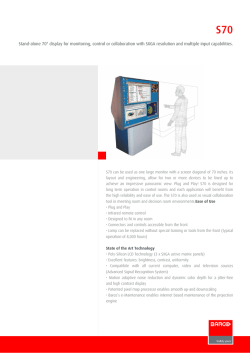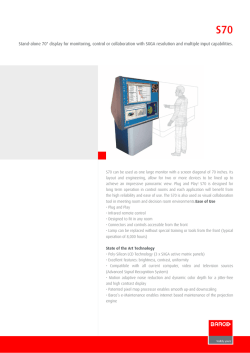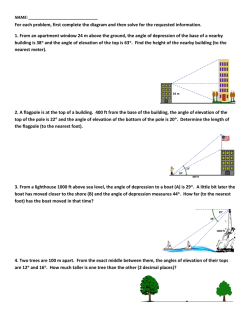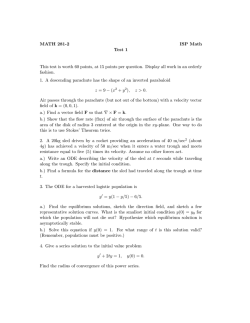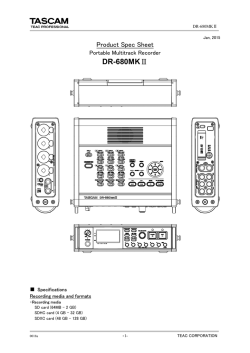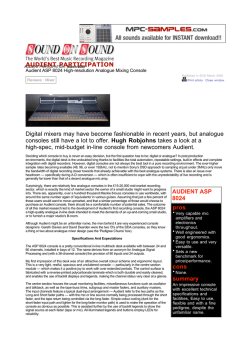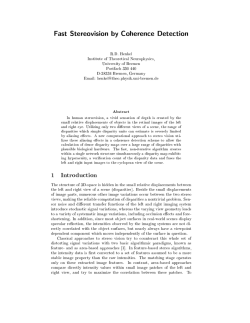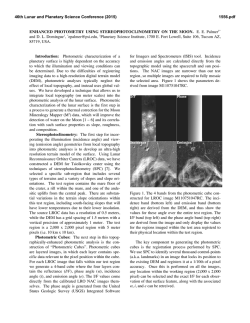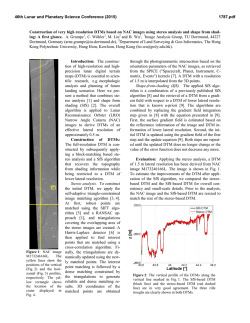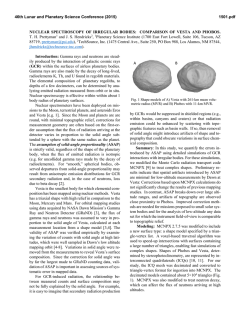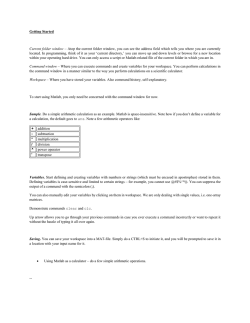
CRITERIA FOR AUTOMATED IDENTIFICATION OF STEREO IMAGE
46th Lunar and Planetary Science Conference (2015) 2703.pdf CRITERIA FOR AUTOMATED IDENTIFICATION OF STEREO IMAGE PAIRS. Kris J. Becker1, Brent A. Archinal1, Trent M. Hare1, Randolph L. Kirk1,3, Elpitha Howington-Kraus1,4, Mark S. Robinson2, Mark R. Rosiek1,4, 1U. S. Geological Survey, Astrogeology Science Center, 2255 N. Gemini Dr., Flagstaff, AZ, 86001 ([email protected]), 2 School of Earth and Space Exploration, Arizona State University, Tempe, AZ 85287; 3Emeritus; 4Retired. Introduction: Stereo imaging forms the basis for much of the 3-D terrain analysis conducted by researchers in the planetary science community. Identifying the data on which to conduct stereogrammetry can be complicated and time-consuming [1-3]. While some instrument teams maintain databases of deliberately targeted stereo-pairs (e.g., Mars Reconnaissance Orbiter (MRO) HiRISE [4] and Lunar Reconnaissance Orbiter (LRO) Camera (LROC) [5]) there is no tool to locate fortuitous stereo overlaps, especially for images from different instruments. Here we provide recommended methods and constraints for locating stereo pairs. Many of these recommendations can be tested using a new interactive solution provided by the USGS via the web-based Planetary Image Locator Tool (PILOT) application [6]. Overview: The main criteria to be used in identifying stereo images include: o Image overlap and similar spatial resolution. o 3-D stereo imaging “strength” as computed from emission and spacecraft azimuth angles. o Illumination similarity as computed from incidence and solar azimuth angles. o Similar solar longitude (i.e. it is best to avoid seasonal variations, such as differing frost patterns on Mars). o Compatible spectral wavelength range to achieve similar contrast. Recommendations are separated into two main categories of evaluation: (1) individually identify all candidate images that are suitable for stereo analysis and (2) identify images with common surface coverage that satisfy stereo pairing criteria. For both evaluation categories, the range of acceptable values depends on the intended use and thus most recommendations provided below are not absolute. While we provide specific “recommended” values, one should not take these as necessarily the “optimal” value because there can be a broad range of values that give similar quality without a sharp optimum in usefulness. Image Suitability for Stereo Analysis (1): Generally, criteria for finding useful stereo image candidates are generated for the center pixel of all possible images, although a more robust solution might compare only areas where images share common surface coverage. Incidence Angle. This angle is measured between the local surface normal vector at the surface intercept point (evaluated on a smooth representation of the global shape) and the vector to the Sun (for radar images, replace the sun vector with the radar source). o Limits: Between 40° and 65° depending on smoothness (shadows to be avoided) [7]. o Recommended: Nominally 50° Emission Angle. The angle is measured between the spacecraft-to-surface intercept vector and the local surface normal vector at the intercept point (evaluated on a smooth representation of the global shape). The goal of this criterion is to exclude images with extreme foreshortening (high emission angles for optical, low for radar). o Limits: Between 0° and the complement of the maximum slope (conservatively 45°, greater for smoother terrains) for optical images. Greater than the slope (≥15° even for smooth surfaces) for radar. o Recommended: No recommendation. Phase Angle (optional). Measured as the angle between the spacecraft-to-surface intercept vector and the illumination source (typically the Sun). Surface appearance can vary with phase angle, especially at low phase, so it may be useful to exclude low phase images. o Limits: Between 5° and 120°. o Recommended: ≥ 30° Ground Sampling Distance (GSD). The width of the pixels projected to the surface. o Limits: GSD is chosen based on the desired GSD of the output digital terrain model (DTM). Because typical stereo matching methods do not produce independent height estimates over distances smaller than about 3 to 5 image pixels, the image GSD needs to be 3 to 5 times smaller than the desired DTM GSD. o Recommended: Better than 1/3 of target DTM GSD. Image-Pairs Suitability for Stereo (2): In general, these comparative parameters are evaluated based on the properties of the two images as measured at a common ground point. GSD Ratio. The ratio of the larger to the smaller GSD of the two images at a common point. o Limits: Image pairs with GSD ratios larger than 2.5 can be used but are not optimal, as details only seen in the smaller scale image will be lost. If required, images with ratios greater than ~2.5 should be resampled to the GSD of the lower scale image. o Recommended: Between 1.0 and 2.5. Strength of Stereo. The strength of a stereo pair is measured as the angle between the emission vectors of 46th Lunar and Planetary Science Conference (2015) the two images. This parameter can be generalized (e.g., to cover cases in which both images are oblique) in terms of the Parallax/Height Ratio (dp) computed as shown in Figure 1 and can also be generalized to apply to radar. Physically, dp represents the amount of parallax difference that would be measured between an object in the two images, for unit height. o Limits: Between 0.1 (5°) and 1 (~45°). o Recommended: 0.4 (20°) to 0.6 (30°). Figure 1. Computation of dp scazgnd = spacecraft azimuth ground emi = emission angle X component of parallax vector: px = -tan(emi)*cos(scazgnd) Y component of parallax vector: py = tan(emi)*sin(scazgnd) dp = !(!"1 − !"2)! + (!"1 − !"2)! where 1 & 2 refer to the images of the pair. Note: For radar, substitute cot(emi) for tan(emi). Illumination Compatibility. Variations in illumination degrade matching to some extent even if there are no shadows, but the effect becomes severe if there are shadows and these differ. Compatibility of the images can be measured in terms of the Shadow-Tip Distance (dsh) computed as shown in Figure 2. This is defined as the distance between the tips of the shadows in the two images for a hypothetical vertical post of unit height. The "shadow length" describes the shadow of a hypothetical pole so it applies whether there are actually shadows in the image or not. It's a simple and consistent geometrical way to quantify the difference in illumination. This quantity is computed analogously to dp. These criteria should also apply to radar, but appropriate limits have not been determined. o Limits: 0 to 2.58. o Recommended: 0 Delta Solar Azimuth Angle (optional). In practice, dsh alone does not guarantee similar illumination. The absolute difference in solar azimuth angle between stereo pairs can be optionally constrained. o Limits: 0° to 100°. o Recommended: ≤20° Common Image Stereo Overlap. Amount of common surface coverage between the stereo pair images expressed as a percentage of the smaller area to the larger. Note that stereo convergence obtained by targeting some images off-nadir to increase overlap does not weaken the stereo. o Limits: Between 30% and 100%. o Recommended: 50% to 100%. 2703.pdf Spectral Range. This is the image color as determined by band, filter, or wavelength. Substantial differences in wavelength may degrade stereo matching. o Limits: This is very dependent on the filters, the target, and how colorful the target is. o Recommended: Same or within a spectral difference which is instrument and target dependent. Figure 2. Computation of dsh sunazgnd = solar azimuth ground inc = incidence angle X component of solar vector: shx = -tan(inc)*cos(sunazgnd) Y component of solar vector: shy = tan(inc)*sin(sunazgnd) dsh = !(!ℎ!1 − !ℎ!2)! + (!ℎ!1 − !ℎ!2)! where 1 & 2 refer to the images of the pair. Application of Method: The incidence, emission, phase and GSD limits are applied to winnow out nonstereo image candidates. Image lists that satisfy these individual image suitability requirements are then used to find stereo image sets. Stereo image sets are determined by finding all complements that satisfy the stereo paring constraints first for Common Image Stereo Overlap and then for the constraints on GSD Ratio, Strength of Stereo and Illumination Compatibility. The output results are a set of stereo complement images (one or more) for each image in the seed list (including the seed image, of course), preferably ranked by the dp and dsh criteria. For flexibility, all search parameters (for single image and image pairs) should be enterable as a range of values, allowing the same value in the upper and lower limit to winnow on a single value. Acknowledgements: We would like to thank the MESSENGER, HiRISE and HRSC projects and the LRO Participating Scientist program for funding and support of this work. References: [1] Cook, A., et al. 1996, Planet. Space Sci., 44, no. 10, 1135-1148. [2] Kirk, R. L., et al. 2008, JGR, 113, E00A24, doi:10.1029/2007JE003000. [3] Kirk, R. L., et al. 1999, LPS XXX, Abstract #1857. [4] Mattson, S. et al (2011) LPSC LXII Abstract #1558. [5] Burns, K.N., et al (2012) ISPRS XXII, v. XXXIXB4-483. [6] Balien., M. B., 2015, this conference. [7] Kirk R. L. et al (2015) this conference.
© Copyright 2026
